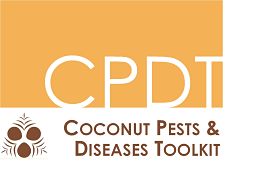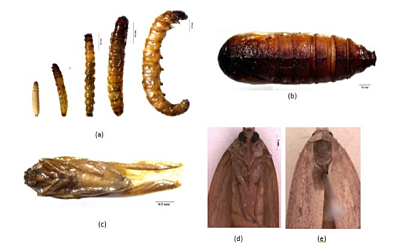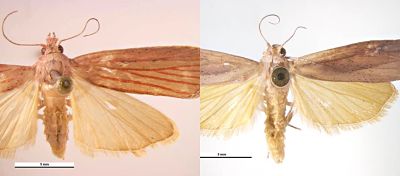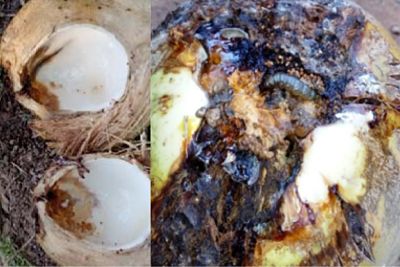Coconut spike moth
The coconut spike moth is a pest insect of coconut within the Pacific. There is a risk of outbreaks which may or may not cause serious damage.
Common nameCoconut spike moth |
Scientific nameTirathaba rufivena |
on this page: Life-cycle and identification : Symptoms : Impacts : Distribution : Prevention : Getting rid of coconut spike moth : Information sources and further reading
Life-cycle and identification
The coconut spike is a moth. Moths are similar to butterflies. It goes through a complete metamorphic life cycle. This consists of egg, larval, pupal and adult stages. Larvae are commonly called caterpillars.
Eggs : Larvae : Pupae : Adults
Eggs
The adult female will lay up to 250 eggs at the base of the leaves and flower spikes (male flowers). They may be laid in small groups or singularly.
After around 6 days, the eggs will hatch into the young caterpillars.
Larvae
Larvae are the caterpillars. They are brown-grey in colour with dark brown heads. Undergoing 5 growth stages (instars) within around 4 weeks, they can reach up to 30 mm long.
The caterpillars are the destructive stage.
Young caterpillars (first and second instar) can be found feeding on the male flowers. Older caterpillars (late instars) will feed in to the female flowers (or fruit).
Long tubes of silk and frass (excrement) can be seen in the flower bunch, and are reddish when fresh and brownish-black when old.
The caterpillars are very active and, when disturbed, will move quickly.
PupaePupation occurs in a cocoon. Cocoons are made from larvae debris, and forms a hard brown shell. The pupae can be found hanging from leaf bases or tucked away within them. The pupa will stay like this for 2 weeks, growing and starting to form adult features until it emerges. AdultsAdults are the moth life stage. The adults have two pairs of wings. The front pair are narrow and brown. The back pair are broad and yellow in colour. There may also be dark marks of colour near the edges of the front wings. Females tend to have red vein-like markings down their front wings while males are silver-gray and the front wings are a slightly darker brown. Adults mate once they have emerged from the pupal stage. Females will lay the eggs. Adult moths live up to 10 days. |
Life stages of the coconut spike moth. a) 5 intars of the larvae b) Cocoon for pupation c) Pupa d) Adult front e) Adult back (© Salmah Yaakop, Centre for Insect Systematics)
Adult spike moths. Female (left) showing red vein-like markings (© Ken Walker, PaDIL) |
Symptoms
|
Caterpillar feeding damage is commonly seen on the male flowers. As the older caterpillars bore in to the nut (female flowers), a hole can be seen with the caterpillars excreted substances (droppings) coming out of it. There may also be a gum-like substance oozing out of the bored hole. When the nut is cut in half, the kernel will show the site of boring and brown stains. The damage to the nut causes it to fall before it is mature. Infestation can cause damage to the growing point of young palms. The growing point may wilt and the palm's development may slow down in severe attacks. |
Nut halves showing brown staining at the site of boring and on the kernel (L) and a gum-like substance oozing out of the bored hole with larvae feeding (R) (© Rajesh K. Patel, AICRP (PALMS)) |
Impacts
The main damage from the coconut spike moth is nuts falling before they are mature. Nut losses will depend on the severity of infestation.
Economic losses are difficult to evaluate due to the natural (early) shed of nuts at about 50%, variable sizes of caterpillar populations and the amount of nuts that are left to mature. If one male and female flower branch (spike) is damaged the next one may not be, compensating for the losses of the other.
Overall losses are reported to be small. The insects may have a high economic impact if only 4-5 nuts mature and the rest are destroyed by a severe attack (damage to around 60% of nuts). The damage done to nuts is generally said to be only 10% or less.
However, the Phillipines, Malayan Dwarf x West African Tall hybrid varieties have shown nearly all of the female flowers in 3 to 5-year old palms to be damaged. This is said to be due to ideal conditions for the moth created by constricted flowers within a compacted crown.
Distribution
The coconut spike moth can be found within Southeast Asia and Oceania. In the Pacific it has been found in Cook Islands, Fiji, Samoa, Solomon Islands, and Tonga.
Prevention
Most importantly, the International Guidelines for transfer of coconut germplasm should be strictly followed to prevent pests and diseases being moved to new locations.
For general information on preventing pests and diseases of coconut, see the Prevention section.
Controlling coconut spike moth
We strongly recommend an integrated pest management (IPM) approach to the control of all insects, where possible. This is a combination of methods (pesticides, physical controls such as site hygiene, and biological controls) to minimise the use of pesticides and minimise the cost of control.
Integrated Pest Management (IPM)
The goal of IPM is to keep pest populations to a level below which they cause economic harm. IPM involves using multiple control options together for the economic control of pests (i.e. cultural, natural and chemical).
In an agricultural context the Food and Agriculture Organization defines IPM as "the careful consideration of all available pest control techniques and subsequent integration of appropriate measures that discourage the development of pest populations and keep pesticides and other interventions to levels that are economically justified and reduce or minimize risks to human health and the environment. IPM emphasizes the growth of a healthy crop with the least possible disruption to agro-ecosystems and encourages natural pest control mechanisms".
Cultural
Larvae can be found in the young nuts that have fallen. Therefore, it is recommended to remove these from the site and destroy them before the insects move to healthy nuts.
Harvest ripe bunches as soon as possible as these can attract moth populations and therefore increase breeding sites.
Natural
Biological control has been attempted. Fiji successfully introduced parasites of the coconut moth from Java including Apanteles tirathabae (braconid wasp), Telenomus tirathabae (scelionidae wasp), Argyrophylax basifulva (tachnid fly) and Venturia palmaris (ichneumonid wasp). These are likely to have helped reduce populations in Fiji.
Similar introductions of parasites were attempted in Samoa and Tonga but establishment was unsuccessful.
Laboratory tests have been done using pathogenic fungi. Beauveria bassiana (white muscardine fungus) was more successful in killing the moth than Metarhizium anisopliae (green muscardine fungus) and may be a possible control agent. Both fungi have been used to target other coconut pests such as beetles and weevils.
Chemical
Chemical control is not recommended. Applying pesticides to tall palms is labour intensive and costly. Pesticides are also likely to kill natural predators of the coconut spike moth and other more serious pests of coconuts.
Information sources and further reading
Mohamad et al. 2017. Biological agents and insecticides to control bunch moth, Tirathaba rufivena in oil palm estates in Sarawak, Malaysia. Journal of Oil Palm Research, 29,3, pp. 323-332.
Organic Soil Technology. 2018. Beauveria bassiana. Entomopathogenic Fungi. [ONLINE]
Patel, Salam, Singh. 2018. New record of coconut spike moth (Tirathaba rufivena Walker) from Bastar tribal belt of Chhattisgarh. Journal of Entomology and Zoology Studies, 6, 1, pp. 1117-1118.
PestNet. 2017. Coconut spike moth. [ONLINE]
Plantwise. 2018. Coconut spike moth (Tirathaba rufivena). [ONLINE]
Walker (PaDIL). 2006. Greater coconut spike moth (Tirathaba rufivena). [ONLINE]
Yaakop, Manaf. 2015. The Bunch Moth of the Tirathaba Species As A Hidden Pest on The Peat Soil of Oil Palm Plantations: Implications of Biological Life Cycles, The DNA Barcoding Approach, and Infestation Pattern Detection. 3rd International Conference on Chemical, Agricultural and Medical Sciences.
content reviewed by Diane Anderson, Plant Health and Environment Laboratory, Ministry of Primary Industries, New Zealand, October 2018



